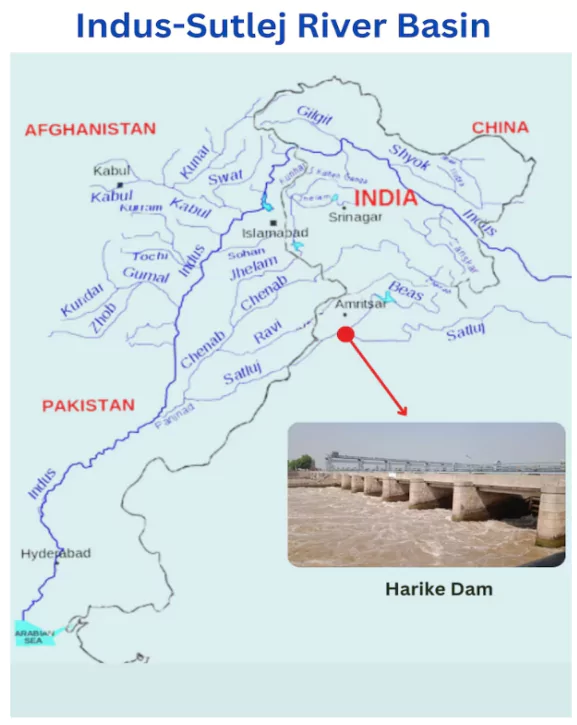Recently, a Supreme Court judge has said the construction of dams on the Sutlej has turned the trans-Himalayan river into a rivulet, altering the entire ecosystem and eco chain.
- He emphasised the critical link between the health of India’s agricultural sector and its rivers. He also elaborated on how climate change is also harming agriculture
Sutlej River

- Origin: The Sutlej River originates in the Rakas lake near Mansarovar at an altitude of 4,555 m in Tibet where it is known as Langchen Khambab.
- River Course:
- The river enters India by flowing west and southwest through the Shipki La Pass in Himachal Pradesh at an altitude of 6,608 metres.
- The river then flows through Punjab near Nangal before meeting the Beas River.
- The merger of these two rivers goes on to form 105 Km of the India-Pakistan border.
- The river continues to flow for another 350 Km before joining the Chenab River.
- The combination of the Sutlej and Chenab Rivers form the Panjnad, which finally flows into the Indus River.
- Length: The total length of the river is about 1550 km of which 529 km is in Pakistan.
- Tributaries: The Sutlej River has many tributaries, including Baspa, Beas, Nogli Khad, Soan and Spiti.
- Significance: It is a very important tributary of Indus and it feeds the canal system of the Bhakra Nangal project.
- Water from the Sutlej River has been allocated to India according to the Indus Waters Treaty of 1960.
- There are various hydroelectric power and irrigation projects over the river like the Kol Dam, Bhakra Nangal Dam, Baspa Hydroelectric Power Project, and Nathpa Jhakri Project
Enroll now for UPSC Online Course
Importance of Rivers to Agriculture
- Primary Source of Irrigation:
-
- Surface Water: Rivers provide a direct source of surface water for irrigation, crucial for crops like rice, wheat, and sugarcane.
- Groundwater Recharge: Rivers help in recharging groundwater aquifers, which are extensively used for irrigation, especially in regions with inadequate surface water.
- Nutrient-Rich Sediments:
- Soil Fertility: Rivers deposit nutrient-rich sediments on agricultural lands during floods, enhancing soil fertility and crop yields.
- Microclimate Regulation:
- Humidity and Temperature Control: Rivers help maintain local microclimates, regulating humidity and temperature, which are vital for crop growth.
Challenges to River Health Affecting Agriculture
- Climate Change:
- Erratic Rainfall Patterns: Unpredictable monsoons and altered rainfall patterns disrupt river flow, affecting water availability for irrigation.
- Temperature Rise: Higher temperatures increase evaporation rates, reducing river water levels and increasing crop water requirements.
- Human Activities:
- Over-Extraction: Excessive withdrawal of river water for agriculture, industry, and domestic use depletes river flow.
- Pollution: Industrial discharge, agricultural runoff, and untreated sewage pollute rivers, degrading water quality and harming soil health.
- Dams and Diversions: Construction of dams and diversion projects alter natural river flow, affecting downstream water availability.
- Soil Degradation and Erosion:
- Deforestation: Clearing of forests for agriculture leads to soil erosion, reducing the land’s ability to retain water.
- Riverbank Encroachment: Urbanization and construction along riverbanks disrupt natural water flow and sedimentation processes.
Check Out UPSC CSE Books From PW Store
Way Forward
- Raising public awareness about environmental laws, the effects of climate change and the need to adopt contemporary practices is the order of the day
- Establishment of a permanent commission in India, similar to the central think tank NITI Aayog, to develop comprehensive solutions to the problem.
- Promoting drip and sprinkler irrigation & Implementing watershed management practices to enhance groundwater recharge and soil conservation.
- River Restoration Projects:
-
- Reforestation and Afforestation: Planting trees along riverbanks to prevent soil erosion and enhance water retention.
- Wetland Conservation: Protecting and restoring wetlands to improve water quality and support biodiversity.
- Renewable Energy: Reducing reliance on hydropower projects that alter river flows by promoting renewable energy sources like solar and wind.
![]() 17 Jul 2024
17 Jul 2024

